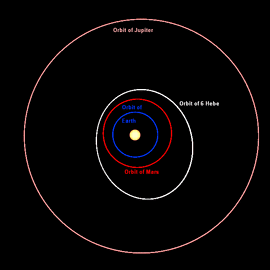Pronunciation /ˈhiːbiː/ HEE-bee Minor planet category Main belt Orbital period 1,380 days | Discovery date July 1, 1847 Alternative names 1947 JB Adjectives Hebean Discovered 1 July 1847 Orbits Sun | |
 | ||
Similar | ||
6 Hebe (/ˈhiːbiː/ HEE-bee) is a large main-belt asteroid, containing around half a percent of the mass of the belt. However, due to its apparently high bulk density (greater than that of the Moon or even Mars), Hebe does not rank among the top twenty asteroids by volume. This high bulk density suggests an extremely solid body that has not been impacted by collisions, which is not typical of asteroids of its size – they tend to be loosely-bound rubble piles.
Contents
In brightness, Hebe is the fifth-brightest object in the asteroid belt after Vesta, Ceres, Iris, and Pallas. It has a mean opposition magnitude of +8.3, about equal to the mean brightness of Titan, and can reach +7.5 at an opposition near perihelion.
Hebe is probably the parent body of the H chondrite meteorites, which account for about 40% of all meteorites striking Earth.
History
Hebe was discovered on 1 July 1847 by Karl Ludwig Hencke, the sixth asteroid discovered. It was the second and final asteroid discovery by Hencke, after 5 Astraea. The name Hebe, goddess of youth, was proposed by Carl Friedrich Gauss.
On March 5, 1977 Hebe occulted Kaffaljidhma (γ Ceti), a moderately bright 3rd-magnitude star. No other observed occultations by Hebe have been reported.
Major meteorite source
Hebe is the probable parent body of the H chondrite meteorites and the IIE iron meteorites. This would imply that it is the source of about 40% of all meteorites striking Earth. Evidence for this connection includes the following:
Physical characteristics
Lightcurve analysis suggests that Hebe has a rather angular shape, which may be due to several large impact craters. Hebe rotates in a prograde direction, with the north pole pointing towards ecliptic coordinates (β, λ) = (45°, 339°) with a 10° uncertainty. This gives an axial tilt of 42°.
It has a bright surface and, if its identification as the parent body of the H chondrites is correct, a surface composition of silicate chondritic rocks mixed with pieces of iron–nickel. A likely scenario for the formation of the surface metal is as follows:
- Large impacts caused local melting of the iron rich H chondrite surface. The metals, being heavier, would have settled to the bottom of the magma lake, forming a metallic layer buried by a relatively shallow layer of silicates.
- Later sizeable impacts broke up and mixed these layers.
- Small frequent impacts tend to preferentially pulverize the weaker rocky debris, leading to an increased concentration of the larger metal fragments at the surface, such that they eventually comprise ~40% of the immediate surface at the present time.
Moon
As a result of the aforementioned 1977 occultation, a small moon around Hebe was reported by Paul D. Maley. It was nicknamed "Jebe" (see Heebie-jeebies). This is the first modern-day suggestion that asteroids have satellites. It was 17 years later when the first asteroid moon was formally discovered (Dactyl, the satellite of 243 Ida). However, the discovery of Hebe's moon has not been confirmed.
